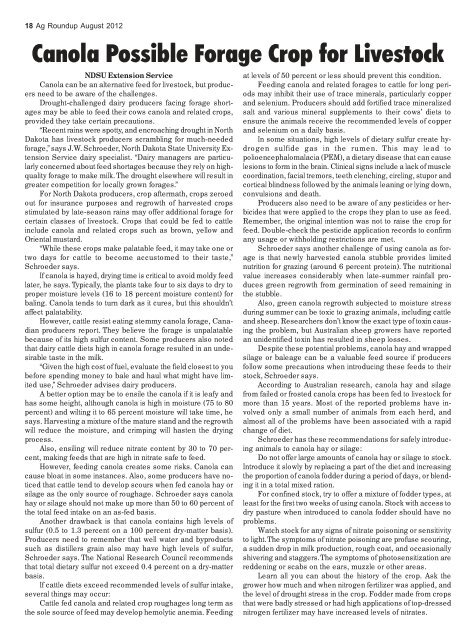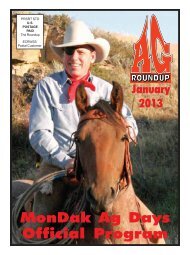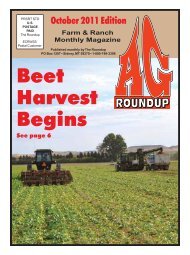to view. - The Roundup
to view. - The Roundup
to view. - The Roundup
Create successful ePaper yourself
Turn your PDF publications into a flip-book with our unique Google optimized e-Paper software.
18 Ag <strong>Roundup</strong> August 2012<br />
Canola Possible Forage Crop for Lives<strong>to</strong>ck<br />
NDSU Extension Service<br />
Canola can be an alternative feed for lives<strong>to</strong>ck, but producers<br />
need <strong>to</strong> be aware of the challenges.<br />
Drought-challenged dairy producers facing forage shortages<br />
may be able <strong>to</strong> feed their cows canola and related crops,<br />
provided they take certain precautions.<br />
“Recent rains were spotty, and encroaching drought in North<br />
Dakota has lives<strong>to</strong>ck producers scrambling for much-needed<br />
forage,” says J.W. Schroeder, North Dakota State University Extension<br />
Service dairy specialist. “Dairy managers are particularly<br />
concerned about feed shortages because they rely on highquality<br />
forage <strong>to</strong> make milk. <strong>The</strong> drought elsewhere will result in<br />
greater competition for locally grown forages.”<br />
For North Dakota producers, crop aftermath, crops zeroed<br />
out for insurance purposes and regrowth of harvested crops<br />
stimulated by late-season rains may offer additional forage for<br />
certain classes of lives<strong>to</strong>ck. Crops that could be fed <strong>to</strong> cattle<br />
include canola and related crops such as brown, yellow and<br />
Oriental mustard.<br />
“While these crops make palatable feed, it may take one or<br />
two days for cattle <strong>to</strong> become accus<strong>to</strong>med <strong>to</strong> their taste,”<br />
Schroeder says.<br />
If canola is hayed, drying time is critical <strong>to</strong> avoid moldy feed<br />
later, he says. Typically, the plants take four <strong>to</strong> six days <strong>to</strong> dry <strong>to</strong><br />
proper moisture levels (16 <strong>to</strong> 18 percent moisture content) for<br />
baling. Canola tends <strong>to</strong> turn dark as it cures, but this shouldn’t<br />
affect palatability.<br />
However, cattle resist eating stemmy canola forage, Canadian<br />
producers report. <strong>The</strong>y believe the forage is unpalatable<br />
because of its high sulfur content. Some producers also noted<br />
that dairy cattle diets high in canola forage resulted in an undesirable<br />
taste in the milk.<br />
“Given the high cost of fuel, evaluate the field closest <strong>to</strong> you<br />
before spending money <strong>to</strong> bale and haul what might have limited<br />
use,” Schroeder advises dairy producers.<br />
A better option may be <strong>to</strong> ensile the canola if it is leafy and<br />
has some height, although canola is high in moisture (75 <strong>to</strong> 80<br />
percent) and wilting it <strong>to</strong> 65 percent moisture will take time, he<br />
says. Harvesting a mixture of the mature stand and the regrowth<br />
will reduce the moisture, and crimping will hasten the drying<br />
process.<br />
Also, ensiling will reduce nitrate content by 30 <strong>to</strong> 70 percent,<br />
making feeds that are high in nitrate safe <strong>to</strong> feed.<br />
However, feeding canola creates some risks. Canola can<br />
cause bloat in some instances. Also, some producers have noticed<br />
that cattle tend <strong>to</strong> develop scours when fed canola hay or<br />
silage as the only source of roughage. Schroeder says canola<br />
hay or silage should not make up more than 50 <strong>to</strong> 60 percent of<br />
the <strong>to</strong>tal feed intake on an as-fed basis.<br />
Another drawback is that canola contains high levels of<br />
sulfur (0.5 <strong>to</strong> 1.3 percent on a 100 percent dry-matter basis).<br />
Producers need <strong>to</strong> remember that well water and byproducts<br />
such as distillers grain also may have high levels of sulfur,<br />
Schroeder says. <strong>The</strong> National Research Council recommends<br />
that <strong>to</strong>tal dietary sulfur not exceed 0.4 percent on a dry-matter<br />
basis.<br />
If cattle diets exceed recommended levels of sulfur intake,<br />
several things may occur:<br />
Cattle fed canola and related crop roughages long term as<br />
the sole source of feed may develop hemolytic anemia. Feeding<br />
at levels of 50 percent or less should prevent this condition.<br />
Feeding canola and related forages <strong>to</strong> cattle for long periods<br />
may inhibit their use of trace minerals, particularly copper<br />
and selenium. Producers should add fortified trace mineralized<br />
salt and various mineral supplements <strong>to</strong> their cows’ diets <strong>to</strong><br />
ensure the animals receive the recommended levels of copper<br />
and selenium on a daily basis.<br />
In some situations, high levels of dietary sulfur create hydrogen<br />
sulfide gas in the rumen. This may lead <strong>to</strong><br />
polioencephalomalacia (PEM), a dietary disease that can cause<br />
lesions <strong>to</strong> form in the brain. Clinical signs include a lack of muscle<br />
coordination, facial tremors, teeth clenching, circling, stupor and<br />
cortical blindness followed by the animals leaning or lying down,<br />
convulsions and death.<br />
Producers also need <strong>to</strong> be aware of any pesticides or herbicides<br />
that were applied <strong>to</strong> the crops they plan <strong>to</strong> use as feed.<br />
Remember, the original intention was not <strong>to</strong> raise the crop for<br />
feed. Double-check the pesticide application records <strong>to</strong> confirm<br />
any usage or withholding restrictions are met.<br />
Schroeder says another challenge of using canola as forage<br />
is that newly harvested canola stubble provides limited<br />
nutrition for grazing (around 6 percent protein). <strong>The</strong> nutritional<br />
value increases considerably when late-summer rainfall produces<br />
green regrowth from germination of seed remaining in<br />
the stubble.<br />
Also, green canola regrowth subjected <strong>to</strong> moisture stress<br />
during summer can be <strong>to</strong>xic <strong>to</strong> grazing animals, including cattle<br />
and sheep. Researchers don’t know the exact type of <strong>to</strong>xin causing<br />
the problem, but Australian sheep growers have reported<br />
an unidentified <strong>to</strong>xin has resulted in sheep losses.<br />
Despite these potential problems, canola hay and wrapped<br />
silage or baleage can be a valuable feed source if producers<br />
follow some precautions when introducing these feeds <strong>to</strong> their<br />
s<strong>to</strong>ck, Schroeder says.<br />
According <strong>to</strong> Australian research, canola hay and silage<br />
from failed or frosted canola crops has been fed <strong>to</strong> lives<strong>to</strong>ck for<br />
more than 15 years. Most of the reported problems have involved<br />
only a small number of animals from each herd, and<br />
almost all of the problems have been associated with a rapid<br />
change of diet.<br />
Schroeder has these recommendations for safely introducing<br />
animals <strong>to</strong> canola hay or silage:<br />
Do not offer large amounts of canola hay or silage <strong>to</strong> s<strong>to</strong>ck.<br />
Introduce it slowly by replacing a part of the diet and increasing<br />
the proportion of canola fodder during a period of days, or blending<br />
it in a <strong>to</strong>tal mixed ration.<br />
For confined s<strong>to</strong>ck, try <strong>to</strong> offer a mixture of fodder types, at<br />
least for the first two weeks of using canola. S<strong>to</strong>ck with access <strong>to</strong><br />
dry pasture when introduced <strong>to</strong> canola fodder should have no<br />
problems.<br />
Watch s<strong>to</strong>ck for any signs of nitrate poisoning or sensitivity<br />
<strong>to</strong> light. <strong>The</strong> symp<strong>to</strong>ms of nitrate poisoning are profuse scouring,<br />
a sudden drop in milk production, rough coat, and occasionally<br />
shivering and staggers. <strong>The</strong> symp<strong>to</strong>ms of pho<strong>to</strong>sensitization are<br />
reddening or scabs on the ears, muzzle or other areas.<br />
Learn all you can about the his<strong>to</strong>ry of the crop. Ask the<br />
grower how much and when nitrogen fertilizer was applied, and<br />
the level of drought stress in the crop. Fodder made from crops<br />
that were badly stressed or had high applications of <strong>to</strong>p-dressed<br />
nitrogen fertilizer may have increased levels of nitrates.
















